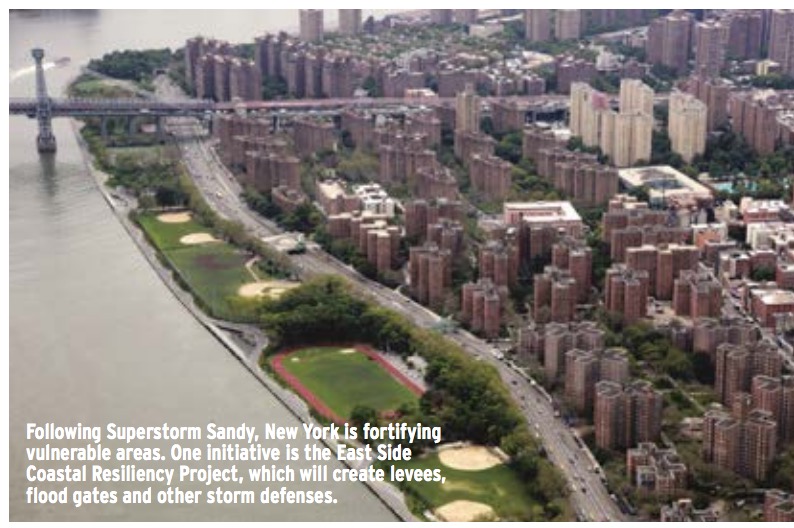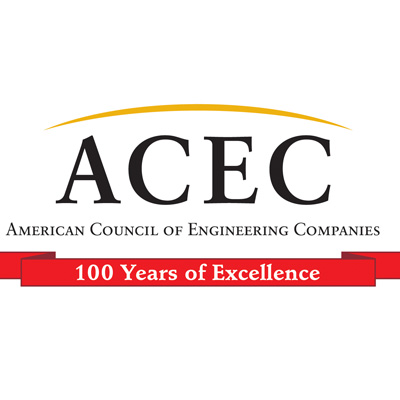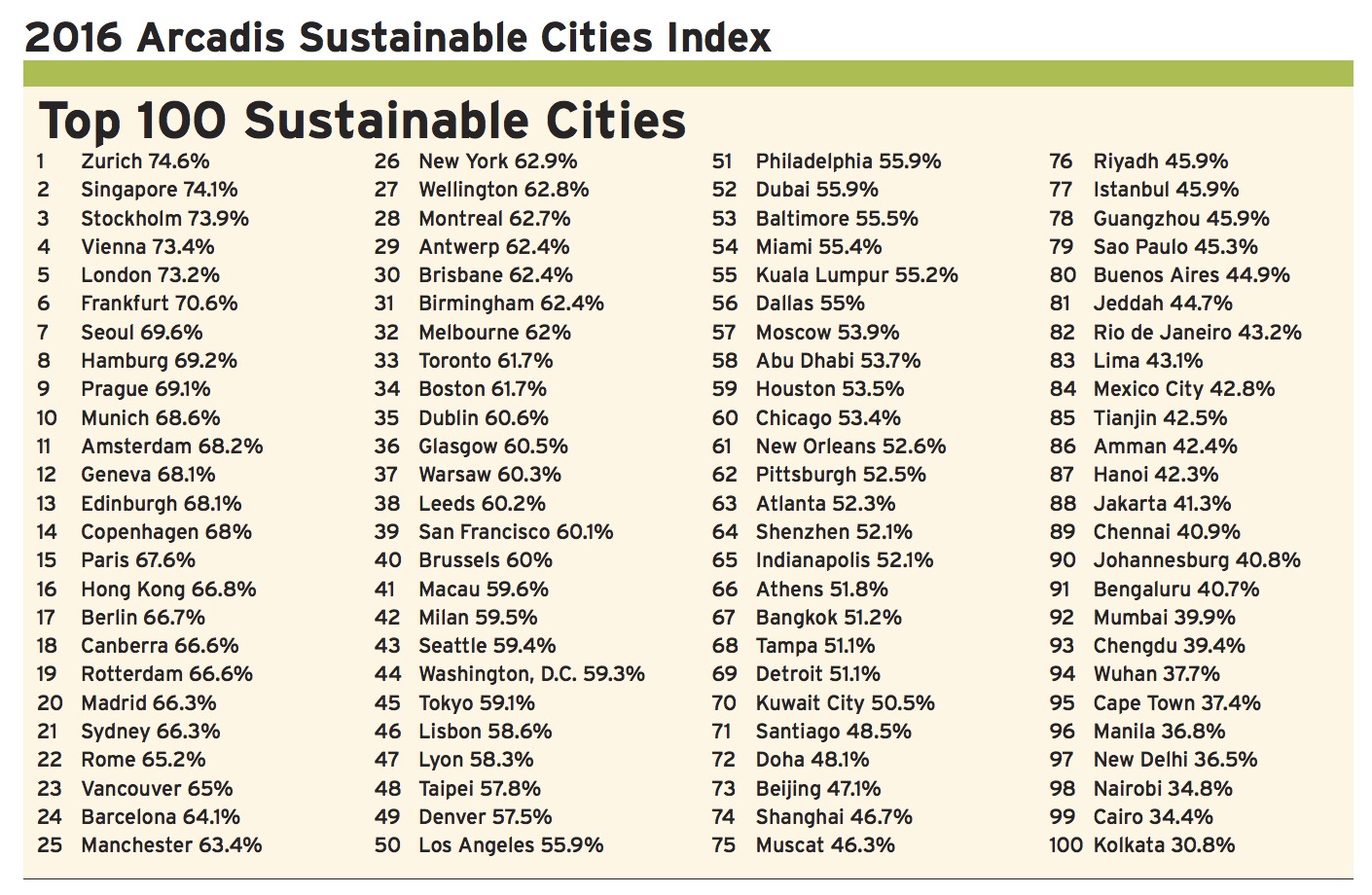AMERICAN COUNCIL OF ENGINEERING COMPANIES (ACEC)
Annual Arcadis study reveals how U.S. cities stack up against global counterparts and the pivotal role engineers play in boosting U.S. competitiveness
By Alan Joch
To understand what makes a city sustainable and why that’s important, engineers should look to Zurich, which ranks first in the 2016 Arcadis Sustainable Cities Index. It’s widely recognized as a “green” city, thanks to a commitment to reduce average energy usage and draw 75 percent of its energy from renewable sources. It’s also one of the world’s leading financial hubs, and its trams, trains, buses and light rail lines are models of urban efficiency.
“From an economic perspective, as a city becomes more sustainable, it also becomes more attractive to people and businesses,” says Holger Dalkmann, director at the World Resources Institute’s Center for Sustainable Cities, which, along with the Centre for Economics and Business Research (CEBR), compiled the Arcadis Sustainable Cities Index. “This is important because there’s now a growing global competition among cities.”
That competition means sustainability projects represent new opportunities for engineers—no matter their specialties.
“We’re the implementers of sustainability solutions—be them civil, environmental, transportation, resiliency or water,” says John Batten, global director of water and cities at Arcadis. “These are the solutions that ultimately make cities more sustainable.”
But what exactly is a sustainable city? Various research organizations weigh individual factors differently, but there’s consensus around key characteristics.
“Sustainable cities have people at their hearts,” says Caroline Assaf, president of Sustainable Cities International in Burnaby, British Columbia. “They balance physical, social and economic assets to provide people with healthy and resilient communities that are less vulnerable to risks and promote collaboration and inclusiveness among people. Factors like these, in turn, attract businesses, investments, talent and tourism.”
Cities Ascendant
Cities are home to more of the world’s population than ever. The World Health Organization (WHO) says urban areas accounted for 54 percent of global population in 2014 versus 34 percent in 1960. As people gravitate to cities, they’re expecting a better quality of life. To sustain and support this growth, which WHO estimates will be nearly 2 percent every year until 2020, cities must invest in the future. In addition to an infrastructure that promotes economic growth, that means affordable housing, fresh air and drinking water, easy access to public transportation, and education and health care resources.
With these multifaceted aspects of livability in mind, Arcadis and CEBR evaluated 100 cities throughout the world using three sustainability dimensions:
Quality of Life: The people subindex rates health (life expectancy and obesity), education (literacy and universities), income inequality, work-life balance, the dependency ratio, crime, and housing and living costs.
Green Factors: The planet subindex ranks cities on energy consumption and renewable energy share, green space within cities, recycling and composting rates, greenhouse gas emissions, natural catastrophe risk, drinking water, sanitation and air pollution.
Economic Health: The profit subindex examines performance from a business perspective, combining measures of transportation infrastructure (rail, air and traffic congestion), ease of doing business, tourism, gross domestic product per capita, the city’s importance in global economic networks, access to mobile and broadband services and employment rates.
(None of the cities, even those in the top of the composite index, effectively balance all three subindexes, the researchers say. For example, although Zurich posted the best overall score and ranked at or near the top for planet and profit, it came in 27th place for people.)
Zurich wasn’t the only European city that ranked highly in the composite index. In fact, European cities dominated the overall rankings, taking 13 of the top 15 places. This includes the global hubs of London (No. 5), Frankfurt (No. 6) and Paris (No. 15).
What about North American cities? The index found they have a lot to learn from their international peers. Vancouver was the continent’s leader at 23rd in the overall ratings, while U.S. cities failed to enter the top quartile. The closest contender was New York City at 26th place.
Infrastructure differences help explain why European cities outpaced U.S. and Canadian counterparts. Many European urban centers were settled before the automobile age and, as a result, are densely settled and supported by well-established public transportation systems. However, many American cities outside the Northeast grew with automobiles in mind. “Carcentric designs can lead to urban sprawl and a large carbon footprint, with enormous costs,” Dalkmann says. “Those are fundamental challenges for U.S. cities in terms of sustainability.”
His organization is part of The New Climate Economy (NCE), a global commission that studies links between economies and climate change, and its research bolsters the Sustainable Cities Index results. For example, a NCE study compares Spain’s Barcelona (No. 24 in the Sustainable Cities Index) with Atlanta (No. 63), two cities with approximately 2.5 million residents. “Atlanta has five times more total area than Barcelona, and its carbon footprint is six times higher,” he points out. “Where there’s urban sprawl, research shows there are more challenges in terms of access to jobs and schools and in environmental quality.”
But density and transportation aren’t the only differentiating factors. “Europeans recycle and recover resources from municipal solid waste much more than American cities do on a whole,” Batten says. He adds that better work-life balance, access to public health care and lower homicide rates also gave the top 20 municipalities an edge in the composite Sustainable Cities Index.
Signs of Progress
Although North American cities lagged many in Europe, the latest index results offers signs of progress, particularly in the various subindexes in the Arcadis research. Experts say much of the improvement is linked to the direct involvement of engineers during all phases of the project development life cycle. For example, New York ranked 26th place overall, but for profit it holds an impressive 8th place. Its 33rd ranking for planet is the best in the U.S., and initiatives are underway that may boost its green profile even more. PlaNYC, an engineering-intensive initiative, is evolving the city’s image of grit and grime into a more people-friendly destination thanks to targets for reducing carbon emissions, networks of bike paths and a pedestrian mall in the formerly car-congested Times Square. “Projects like these are propelling New York into a strong urban brand in terms of sustainability,” Batten says.
The city recently expanded PlaNYC’s objectives with targets for more housing that’s affordable for a broad range of incomes to keep police and fire professionals, nurses, teachers and others in the city. “The more diverse a city is, the more vibrant it is,” Batten explains.
Resiliency in the age of climate change has also become a priority. The city upgraded building codes to prepare for extreme floods and winds in the wake of 2012’s destructive Superstorm Sandy. Arcadis and other engineering firms are actively involved in fortifying vulnerable areas of Manhattan and other boroughs. One of the most prominent initiatives is the East Side Coastal Resiliency Project, which will create levees, flood gates and other storm defenses in lower Manhattan. “Sitting on top of them is expected to be parkland and recreational facilities for the downtown community,” Batten says.
On the West Coast, Los Angeles (No. 50 in the overall Sustainable Cities Index and No. 60 for planet) has set goals for improving business, environmental and lifestyle characteristics with its Sustainable City pLAn. A year into the initiative, the mayor’s office says the plan helped reduce water use by 19 percent. The city’s efforts got a boost in the last election when voters approved Measure R, a multidecade infrastructure project for expanding metro and regional rail service, adding to the rapid transit system, earthquake-proofing bridges and other improvements.
In the Midwest, Chicago (No. 60 overall and No. 67 for planet) is continuing its Sustainable Chicago program, which is developing more than 225 miles of bike lanes and expanding a bike-sharing program. The Department of Water Management is replacing 100 miles of water and sewer lines a year, while the Metropolitan Water Reclamation District is investigating more energy-efficient technologies for the city’s water infrastructure.
Takeaways for Engineers
Whether sustainability starts with resiliency efforts, greenways or expanded mass transit resources, the projects create positive ripple effects for communities and the engineering industry in particular.
 “We’re seeing that everywhere you add a new rail line, for example, you create a redevelopment corridor that renews the housing stock and expands transportation networks along that route,” Batten says. “This creates a great uplift for the engineering and architectural businesses that serve those areas.”
“We’re seeing that everywhere you add a new rail line, for example, you create a redevelopment corridor that renews the housing stock and expands transportation networks along that route,” Batten says. “This creates a great uplift for the engineering and architectural businesses that serve those areas.”
For its part, Arcadis is involved in a number of resiliency projects. One is a new rail station in the centuries-old Dutch city of Rotterdam. When complete, the station will handle three times more passengers than the old facility. The project is part of an ambitious modernization effort that is using engineering expertise to redevelop city waterfronts and revitalize an abandoned port area.
“The waterfront opportunities are clearly a place where engineers can practice their art by designing dikes, berms and bridges that make the areas more resilient to severe weather and accessible to citizens,” Batten says.
Engineering companies are active participants in sustainability projects such as these, providing input during the early development, as well as the designs that bring these complex initiatives to life.
“Having more engineers thinking about the bigger picture and understanding the goals of cities directly impacts the overall success of sustainability efforts,” Dalkmann says. “For example, we have worked on the bus rapid transit systems in many countries, and our research shows that with high-quality designs that promote ridership, cities can reduce traffic fatalities by as much as 30 percent.”
Considering the declining reserves of nonrenewable energy resources and the growing competition among cities to attract people and businesses, engineers will become even more pivotal for progressive cities.
“Sustainable development is quickly becoming the only option,” Assaf says. “The question is, what cities will be willing to make this transition to sustainability on their own terms, and which ones will wait until they’re forced to make an even more rapid transition when they no longer have a choice?”
Download full version (PDF): What U.S. Cities Can Learn From European Peers
Download May/June issue of Engineering, Inc.
 About the American Council of Engineering Companies
About the American Council of Engineering Companies
www.acec.org
The American Council of Engineering Companies (ACEC) is the voice of America’s engineering industry. Council members – numbering more than 5,000 firms representing more than 500,000 employees throughout the country – are engaged in a wide range of engineering works that propel the nation’s economy, and enhance and safeguard America’s quality of life. These works allow Americans to drink clean water, enjoy a healthy life, take advantage of new technologies, and travel safely and efficiently. The Council’s mission is to contribute to America’s prosperity and welfare by advancing the business interests of member firms.
Tags: ACEC, American Council of Engineering Companies, Arcadis, Engineering, Engineering Inc., Engineers







 RSS Feed
RSS Feed